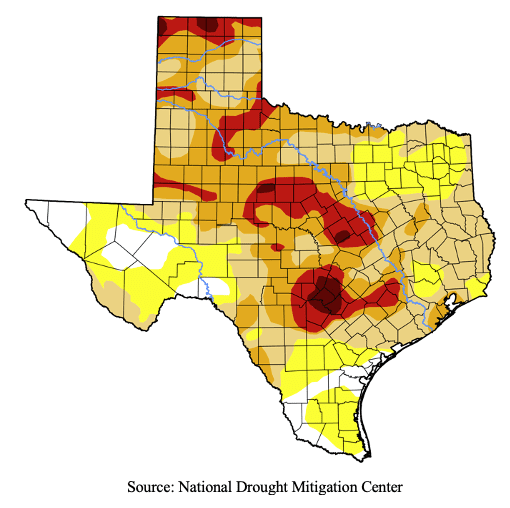
Return to November 2022 newsletter
Drought’s impacts on Texas groundwater resources
By Kyle K. Weldon and Jim D. Bradbury
James D. Bradbury, PLLC
Rainfall over the past several weeks has been a nice change of pace for the majority of Texas; however, the state continues to experience severe drought.
As of the first week of November, the U.S. Drought Monitor for Texas reports over 90% of the state is in drought conditions, with approximately 22% of the state considered “Abnormally Dry,” 27% of the state classified as experiencing “Severe Drought,” and 1.7% in an “Exceptional Drought.”
The pictured map shows the drought intensity for Nov. 3.
On the surface, the drought has certainly impacted hay production and pasture conditions, and Texas’ lakes and reservoirs across the state are currently 68% full, down from almost 80% a year ago. However, under the surface, Texas’ groundwater resources have also been hit hard by the drought. Looking at some of the counties with concentrated dairy production, aquifer levels appear to be consistently lower than those reported a year ago:
- Ogallala Aquifer (Dallam County) – water level down 3.5 feet from 1 year ago
- Ogallala Aquifer (Hartley County) – water level down 2.65 feet from 6 months ago
- Trinity Aquifer (Erath County) – water level down 2.17 feet from 1 year ago
- Ogallala Aquifer (Potter County) – water level down 1.9 feet from 1 year ago
- Ogallala Aquifer (Lamb County) – water level down 0.88 feet from 1 year ago
On an extreme level, the water level in the Trinity Aquifer northwest of San Antonio is reporting to be down 105 feet from a year ago.
While aquifer levels will continue to fluctuate as Texas hopefully receives more moisture this fall, because agriculture relies more heavily on groundwater (using approximately 75% of groundwater used in Texas), actively monitoring these levels is important.